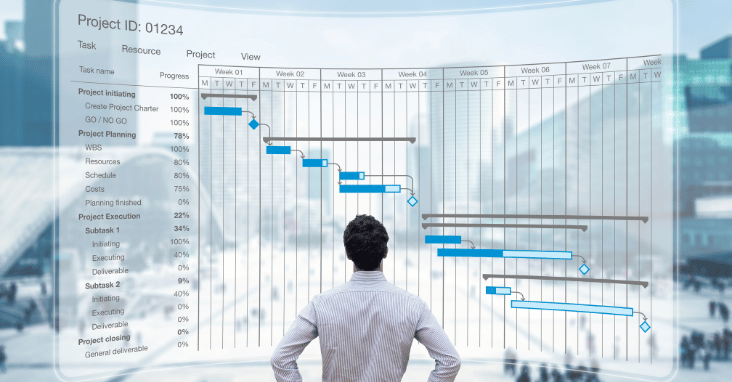Critical Chain Project Management (CCPM) is a method that uses buffer management to protect project completion dates from uncertainty. It focuses on critical activities and uses buffers and “drum-buffer-rope” technique to synchronize workflow and keep projects on schedule.
At its core, Critical Chain Project Management emphasizes the interdependency of project tasks and the importance of managing uncertainty. By creating a robust schedule that accounts for potential setbacks, CCPM aims to improve project performance and increase predictability.
In this post, we will explore the key concepts and principles of Critical Chain Project Management, including the critical chain, buffer management, and resource optimization. We will also examine the benefits of CCPM, including improved project completion rates and increased efficiency. Additionally, we will discuss the implementation considerations, such as identifying the critical chain, creating a project buffer, and managing resources.
What is Critical Chain Project Management?
Critical Chain Project Management (CCPM) is a method that aims to optimize the use of resources and improve project performance. It is based on the concept of the critical chain, which is the sequence of tasks that determine the overall duration of the project. CCPM emphasizes managing the critical path and creating a robust schedule that accounts for the uncertainties that inevitably arise in projects.
This method differs from traditional project management approaches in that it prioritizes the critical chain and buffers resources to mitigate potential setbacks. By focusing on the critical path and managing uncertainties, CCPM aims to increase project completion rates, efficiency, and predictability.
In Critical Chain Project Management, a buffer is added to the end of the project to account for any unforeseen delays or obstacles. The buffer is then managed throughout the project, and if tasks are completed ahead of schedule, the buffer is used to accelerate the completion of the critical chain.
Benefits of CCPM
The benefits of Critical Chain Project Management (CCPM) are numerous and include improved project completion rates, increased efficiency, and productivity, better resource utilization, and reduced project lead times.
One of the primary benefits of Critical Chain Project Management is that it increases the likelihood of completing projects on time. By focusing on the critical chain and managing uncertainties, CCPM minimizes the risk of delays and obstacles that can cause projects to miss deadlines.
CCPM also improves efficiency and productivity by better-utilizing resources. By managing the critical path, CCPM ensures that resources are used where they are needed most, rather than wasting them on non-critical tasks. This leads to improved resource utilization and a more streamlined project.
Critical Chain Project Management can also lead to a reduction in project lead times. By accelerating the completion of the critical chain and managing the buffer, CCPM allows for faster completion of the project.
CCPM can improve project performance. It takes understanding the process, being open to new ideas, and working with the project team, stakeholders and managers. This method can make the project more efficient and more predictable and give it a better chance of success.
Buffer Types in Critical Chain Project Management
- Project Buffer: A buffer is added to the end of the project to account for any unforeseen delays or obstacles. This buffer is managed throughout the project, and if tasks are completed ahead of schedule, the buffer is used to accelerate the completion of the critical chain.
- Resource Buffer: A resource buffer is used to prevent resource over-allocation and ensure that the project team has enough resources to complete the critical chain on time.
- Feeding Buffer: A feeding buffer is used to ensure that tasks in the critical chain are not delayed by tasks in the non-critical chain.
- Control Buffer: A control buffer is used to track the progress of the project and identify any potential issues or delays.
Implementation of Critical Chain Project Management
Implementing Critical Chain Project Management (CCPM) requires a clear understanding of the process and a willingness to adapt to a new way of thinking. There are several key steps involved in implementing CCPM, including identifying the critical chain, creating a project buffer, managing resources, and monitoring and controlling progress.
The first step in implementing CCPM is identifying the critical chain. The critical chain is the sequence of tasks that determine the overall duration of the project. This is the path that must be completed on time to meet the project deadline. Once the critical chain is identified, non-critical tasks can be minimized or eliminated to focus resources on the critical path.
The next step is creating a project buffer. A buffer is added to the end of the project to account for any unforeseen delays or obstacles. This buffer is managed throughout the project, and if tasks are completed ahead of schedule, the buffer is used to accelerate the completion of the critical chain.
Managing resources is also an essential part of implementing CCPM. By focusing on the critical chain, resources are allocated where they are needed most, rather than wasting them on non-critical tasks. This leads to improved resource utilization and a more streamlined project.
Finally, monitoring and controlling progress are essential for the success of Critical Chain Project Management. This can be done using buffer management techniques, such as buffer status and performance metrics. By regularly monitoring progress, the project team can identify and address any issues as they arise, helping to keep the project on track.
Overall, implementing CCPM can be a challenging process. Still, with a clear understanding of the process and a willingness to adapt to a new way of thinking, it can yield significant improvements in project performance.
Challenges and limitations of Critical Chain Project Management
- Difficulty in accurately identifying the critical chain
- Need for strong leadership and buy-in from project team members
- Potential resistance to change from stakeholders
- Lack of widely accepted standards and best practices for implementation
- Difficulties in proactively addressing the challenges and limitations and being able to benefit from the implementation fully.
Conclusion
Critical Chain Project Management (CCPM) is an effective method for optimizing the use of resources and improving project performance. By focusing on the critical chain and managing the buffer, CCPM can lead to improved project completion rates, increased efficiency, and better resource utilization.
However, it’s critical to remember implementing CCPM can be challenging, and it requires strong leadership and buy-in from project team members and stakeholders. With careful planning, effective communication, and a willingness to adapt to a new way of thinking, organizations can successfully implement Critical Chain Project Management and reap the rewards of improved project performance.
Find the Best Project Management Tools on the Serchen Marketplace















